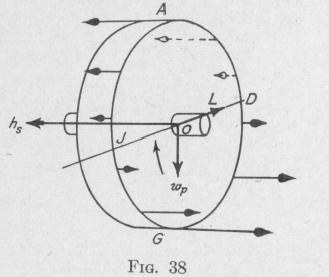48 MOTION OF A SPINNING BODY
angular speed of each particle about the axis JD decreases when the particle is receding from this axis. The angular motion about the axis JD of each particle in the quadrant ODG is decelerating away from the reader (accelerating toward the reader), while the motion of each particle in the quadrant OJA is accelerating away from the reader. Thus, each particle in the quadrant ODG is acted upon by an external force toward the reader, while each particle in the quadrant OJA is acted upon by a force away from the reader.
The resultant of the forces acting on all the particles in the quadrant OAD is represented by the line F,, Fig. 37. The resultants of the forces acting on the particles in each of the other three quadrants are represented by the lines of equal length, F2, F3 and F4, respectively. These forces tend to turn the spin-axle about an axis AG in the direction indicated by the arrow-head marked wp.
It has now been shown that whenever an external torque is applied to a symmetrical unconstrained spinning body, the spin-axis tends to become parallel to the torque-axis, and with the direction of spin in the direction of the torque.
If the unconstrained spinning body be acted upon simultaneously by more than one torque, then the spin-axis tends to set itself parallel to the resultant torque.
In the case of a wheel mounted so that there is a fixed angle between the spin-axis and the torque-axis, the torque-axis retreats from the advancing spin-axis. The spin-axis continues to move in the direction to make it become parallel to the torque-axis, but it cannot become parallel on account of the rigidity of the connection between the wheel and its supporting frame.
31. Precession. - In the preceding Article it has been shown that when a symmetrical unconstrained spinning body is acted upon by an external torque about an axis perpendicular to the spin-axle, the spin-axle will rotate about an axis perpendicular to the axes of spin and of torque. For example, with the directions of spin and of external torque as indicated by the arrows labeled hs and L in Fig. 38, there would be a rotation of the spin-axle about the axis AG in the direction indicated by the arrow labeled wp. It will now be shown that this rotation of the spin-axle develops an internal torque that is in opposition to the applied external torque.
Because of the angular velocity wp, a particle in the semicircle ADGO is approaching the reader, and a particle in the semicircle GJAO is receding from the reader. A particle at either A or G has zero linear velocity and maximum linear acceleration perpen
MOTION OF A SPINNING BODY 49
dicular to the face of the wheel. A particle at either D or J has maximum linear velocity and zero linear acceleration perpendicular to the face of the wheel.
While a particle of the wheel is moving from A to D its inertia opposes the increase of its linear velocity toward the reader by an internal force directed away from the reader. This force is maximum when the particle is at A and zero when it is at D. Thus, all particles from A to D are urged away from the reader. As a particle of the wheel goes from D to G, its inertia opposes the
diminution of the linear velocity
toward the observer. Thus, all particles from D to G are urged toward the reader. As each particle goes from G to J its inertia opposes the increase of linear velocity away from the observer, and hence each particle from G to J is urged toward the observer. As each particle goes from J to A, its inertia opposes the diminution
of linear velocity away from the observer by a force away from the observer. Consequently, the angular velocity about the axis AG develops an internal torque about the L-axis that is in opposition to the external torque about the same axis.
The resisting torque developed when a spinning symmetrical unconstrained body is acted upon by an external torque about an axis perpendicular to the spin-axis, is called gyroscopic resistance or gyroscopic torque. Gyroscopic torques are internal couples which change the direction of the spin-axle without performing work on the body. The angular motion of the spin-axle accompanied by a resisting torque is called precession. The axis about which the spin-axle rotates is called the axis of precession. The angular velocity of the spin-axle about the axis of precession is called the precessional velocity. The precessional velocity is constant when the external torque is of the same magnitude as the internal gyroscopic torque. The external torque that produces or maintains precession is called the precessional couple or precessional torque.
Questions. 1. A contest sometimes seen in military carnivals is a race in
which each contestant rolls a heavy gun wheel around a course. Show that, if the man is running alongside the wheel with the wheel on his right side,
